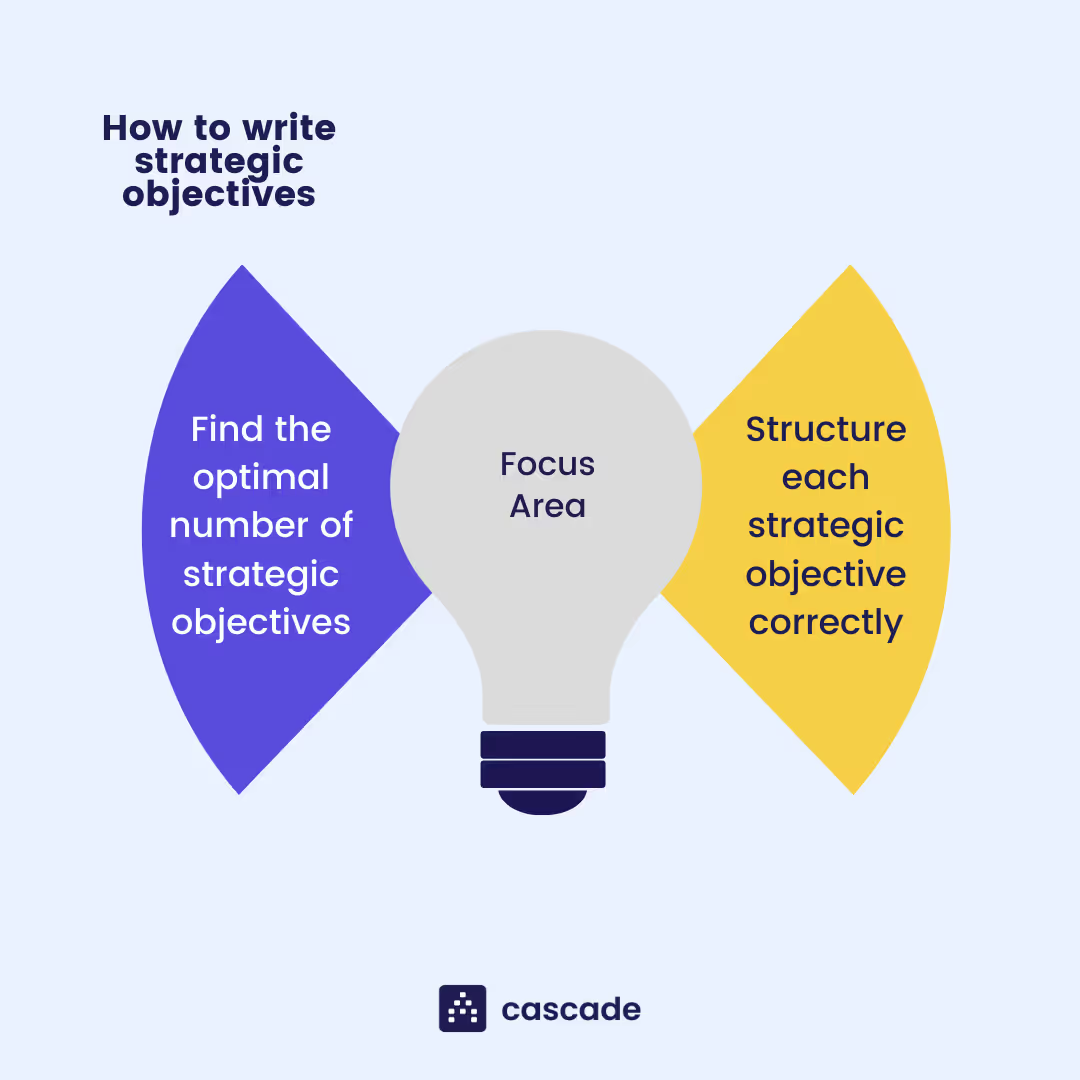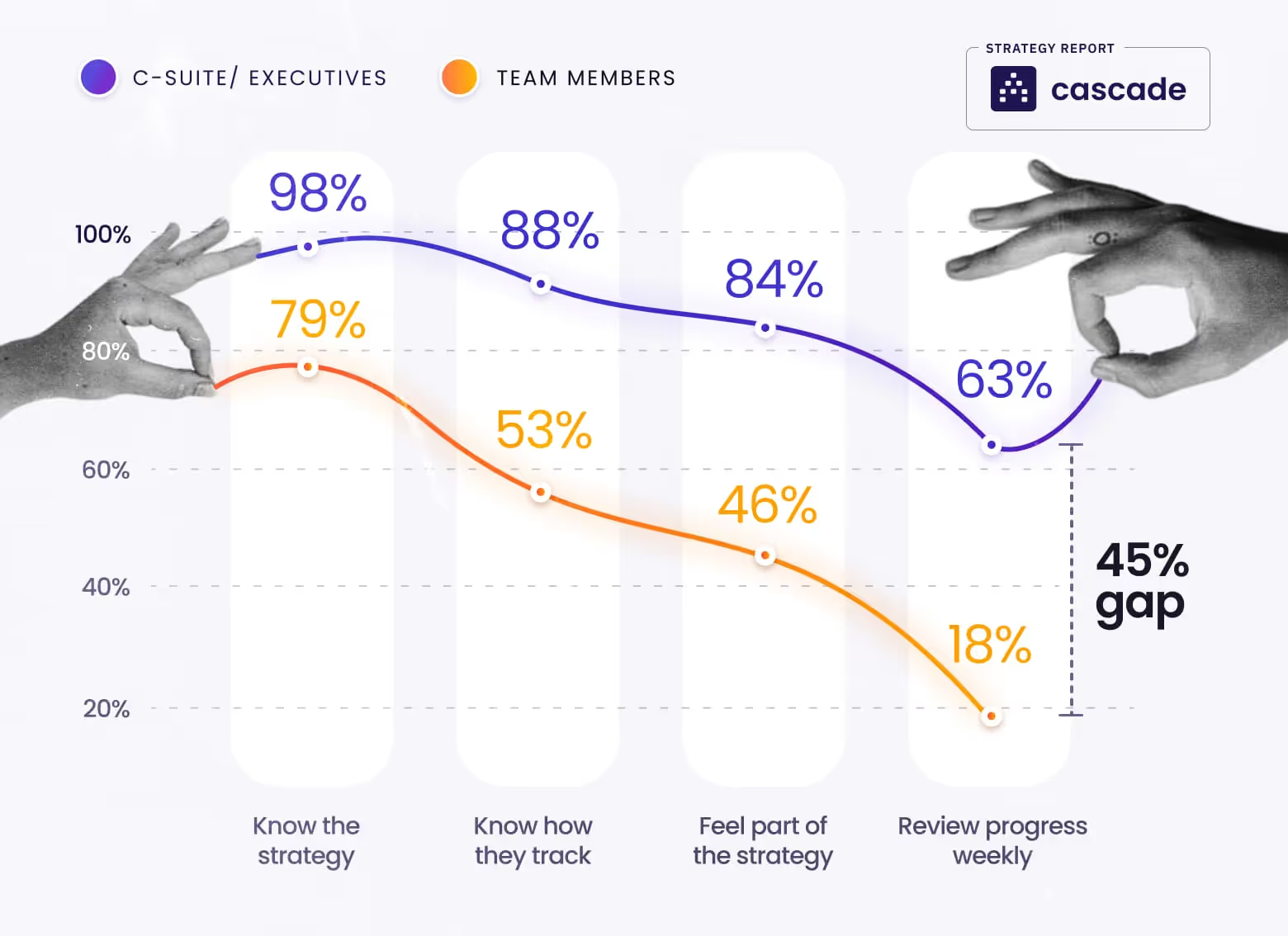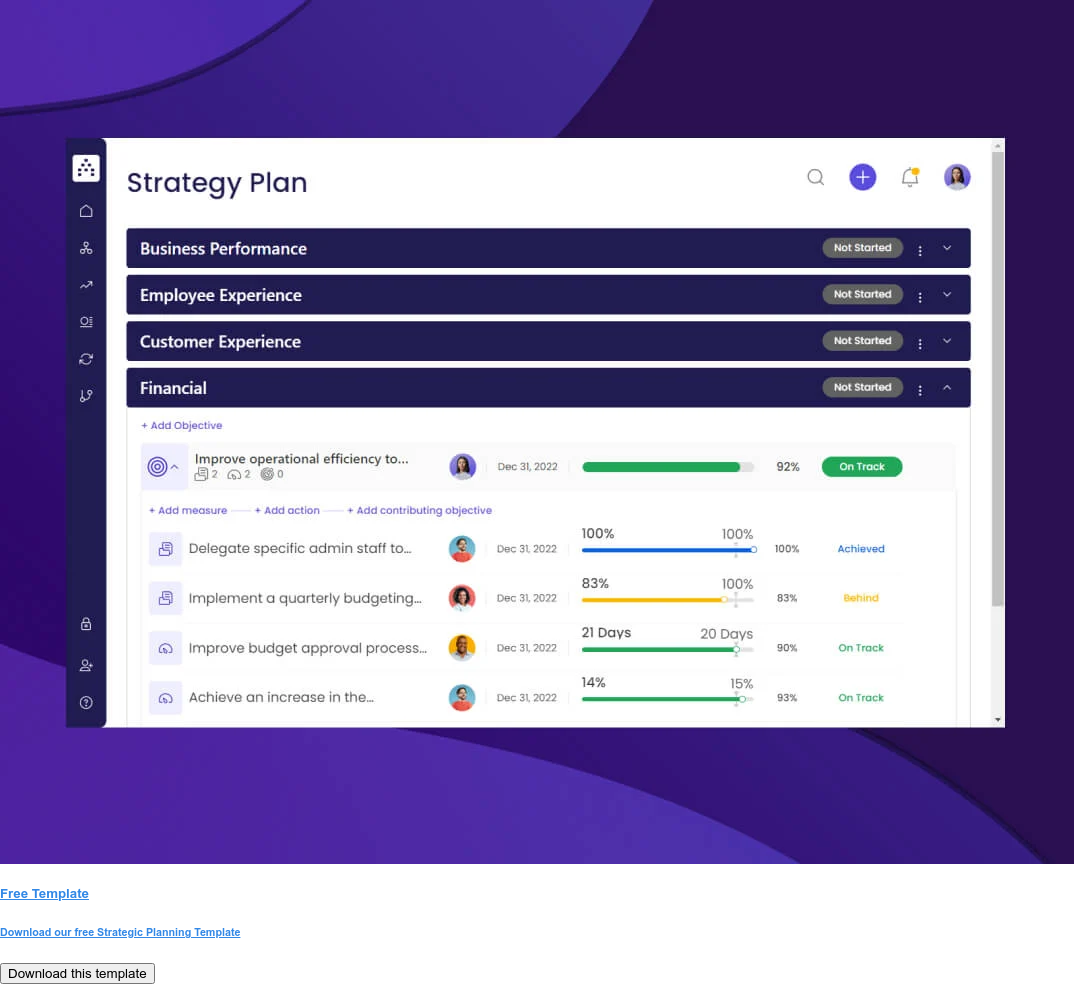Writing strategic objectives is part of the strategic planning process. It’s also most fun and exciting part of it. It follows the creation of your strategy’s focus areas and breathes life into your vision and strategy.
The creation of your strategic plan includes various distinct steps and writing its strategic objectives is one of them.
Overview of strategic planning stages and where strategic objectives fit in:
- How To Write A Strategic Plan: The Cascade Model
- How to Write a Good Vision Statement
- How To Create Company Values
- Creating Strategic Focus Areas
- How To Write Strategic Objectives (This article)
- How To Write an Effective Project
- How To Write KPIs
Each article in the list describes each part of the Cascade Strategy Model in-depth along with how they fit into the bigger picture.
In this article, we’ll take a deep dive into how to write and track strategic objectives. You’ll also get a checklist to test your objectives and a free strategic planning template so you can start tracking them straight away.
.avif)
What Are Strategic Objectives?
Strategic objectives are high-level and measurable goals outlining what an organization wants to achieve, with a clearly defined deadline. They help organizations create strategic roadmaps, initiatives, and projects that are aligned with the company’s strategy and vision.
In Cascade’s strategic planning model, strategic objectives populate your plan’s Focus Areas and are very specific. Each objective contributes to at least one strategic Focus Area and, once completed, is replaced by another.
All of them contribute to the progress toward your Focus Area and, ultimately, your company’s vision statement. In other words, objectives are something that can be tangibly achieved.
For each Focus Area, ask yourself iterations of:
- “What do I have to achieve to accomplish [Focus Area]?”
- “What does it look like to have accomplished [Focus Area]?”
By doing so, you'll be able to identify what needs to be done and set clearer objectives.
How To Write Strategic Objectives?
In terms of setting strategic objectives, you should only be concerned with two things:
- How many strategic objectives should you have?
- What’s the right way to structure them?
We answer both questions in this section.

1. Find the optimal number of strategic objectives
Objective-setting is a prioritization exercise and there’s no magical number for everyone.
But there’s a way to find yours. It lies in the balance between two opposing forces: complacency and focus.
Choose too few objectives and you become complacent, not really challenging your organization to innovate.
Choose too many objectives and you lose your focus, scattering your resources all over the place. Larger organizations tend to be complacent. Smaller organizations tend to be unfocused.
💡Here is a rule of thumb: Choose between 3 and 6 strategic objectives per each of your Focus Areas.
Organize them in order of importance and focus your resources on them. If your Focus Area requires achieving simultaneously 2 or more objectives, then give them equal priority.
If you're not sure how to prioritize them, you can use a risk matrix that will help you evaluate the associated risk with each strategic initiative and allocate resources accordingly.
2. Strategic objective formula: the right structure
Keep things simple.
Strategic objectives should be easy to remember and understandable by everyone within the organization. Keep the language simple and avoid jargon (if possible). Sum up what you want to achieve clearly and concisely.
Each strategic objective must have at least these three elements:
Action + Detail + Deadline
For example:
Create the standard for quality bikes by 31st of December 2024.
💡 Here’s a quick checklist to assess if you wrote a good strategic objective:
- Start off with a verb. This will force you to be specific about what you're trying to do.
- Add the details that make the strategic goal specific.
- Include a deadline to stay on track with progress.
Types of strategic objectives
First, let’s take a look at four different types of strategic objectives that you can consider.
Growth strategic objectives
Growth objectives aim to expand the business and increase market share. They often involve expanding into new markets, developing new products or services, or increasing production capacity.
For example, a growth objective could be to increase the company's presence in the European market by opening new retail locations in major cities across the continent by Q2 2024.
Customer strategic objectives
Customer objectives focus on improving the customer experience and enhancing customer satisfaction. These objectives often involve improving customer service, increasing customer loyalty, and building long-term relationships with customers.
An example of a customer objective could be to implement a customer feedback system and respond to all customer inquiries within 24 hours to improve overall customer satisfaction.
Financial strategic objectives
Financial objectives emphasize improving the financial performance of the organization. They often involve increasing revenue, reducing costs, or improving profitability.
For example, a financial objective could be to reduce operating expenses by 10% by the end of the fiscal year by streamlining operations and eliminating unnecessary expenses.
Social and environmental strategic objectives
This type of objective goes beyond just financial performance and considers the wider impact of an organization's actions. It’s all about creating a positive impact on society and the environment where the organization operates.
An example of a social and environmental strategic objective could be a company's commitment to reduce its carbon footprint or increase community engagement.
Now, it’s time to get more practical. Let’s take a look at how you can set your strategic objectives using the Cascade model.
Strategic Objectives Examples For Business In Practice
Following the Cascade model, you should align your strategic objectives with your strategic priorities, which are also called Focus Areas.
As an example, let’s say that your organization's strategic plan will include the following five Focus Areas:
- Financial Growth
- Operational/Internal Processes Efficiency
- Customer Satisfaction and Loyalty
- Employee Engagement and Retention
- Sustainability and Social Responsibility
Next, gather your data about the current business situation and reverse engineer your company goals. Do a gap analysis that will help you evaluate your current state compared to the desired future state. You can also apply the McKinsey 7s Model which will help you analyze organizational gaps and misalignments preventing you from successfully tackling the business challenge.
Using the approach described above, here are some examples of strategic objectives you could add under each Focus Area:
Market & Financial Growth
- Increase sales by 20% in the next three years.
- Expand into new geographic markets until the end of June 2024.
- Achieve a 20% market share in a specific industry segment within the next three years.
- Increase market share in a new industry by 10% within the next two years.
Operational / Internal Processes Efficiency
- Reduce operating costs by 10% in the next six months.
- Improve supply chain efficiency by reducing lead times by 20% in the next year.
- Develop and launch a new product line within the next two years to diversify revenue streams.
Customer Satisfaction and Loyalty
- Enhance customer satisfaction ratings by 15% in the next year.
- Increase brand awareness by 25% in the next year.
- Increase customer retention by 15% until Q1 2024.
Employee Engagement and Retention
- Achieve a 90% employee retention rate in the next two years.
- Improve employee productivity by 15% in the next year.
- Increase diversity in the workplace by 25% by Q4 2024.
- Introduce a performance-based incentive program by 01/01/2024.
Sustainability and Social Responsibility
- Reduce the carbon footprint by 20% in the next two years.
- Increase shareholder value by 25% in the next three years.
- Reduce waste by 50% in the next three years.
📚Recommended read: 25 Best Strategic Objectives Examples
How To Achieve Strategic Objectives Through Accountability?
To successfully achieve strategic objectives, it's not enough to just write them down. Execution is the other side of the coin, and it requires accountability at all levels of the organization.
While the leader is ultimately responsible for the company's strategy, team members must also be held accountable to maintain momentum.
According to Cascade’s Strategy Report, there’s a significant discrepancy between how frequently team members and C-suite executives review progress. The report found that only 18% of team members review progress weekly, compared to 64% of C-suite/executives.

This statistic highlights the importance of establishing ownership and accountability for strategic objectives and initiatives at a team level.
Without clear ownership and delegation of objectives, failure is almost inevitable.
For example, in Cascade, you can easily assign owners to each objective and enforce accountability. You’ll be able to have full visibility into your team’s performance and the progress of your objectives—all in one place, without having to switch between multiple spreadsheets and disconnected business tools. This approach will help you achieve better execution and drive real results from strategic objectives.
💡Tip: Assign too many owners to each strategic objective and you risk falling into a situation where people become overly reliant on “someone else” to own the goal. Far more people will be involved in the delivery through a series of linked projects, KPIs, and objectives. But you want at most two people to be responsible for the ultimate delivery of the strategic objective.
7 Tips And Best Practices For Setting Strategic Objectives
Following this guide should get you off to a good start with writing your strategic objectives. Here are a few tips to keep in mind:
- Don't be afraid to iterate and adapt. You probably won't get things right the first time. That’s OK. Sometimes you need to get your strategic objectives out on paper to realize where the gaps are.
- Involve the people of your organization as early as possible. Don't sit in a room and try to do things yourself. Define your vision, values, and focus areas—and use that to help structure a broader engagement with your key stakeholders about what your strategic objectives should be.
- Expose your strategic objectives to your people. No matter how simple or well-crafted your strategic objectives are, you need to constantly remind your people and have them regularly engage with them. Use a dynamic digital platform like Cascade to achieve this.
- Reverse engineer your strategic objectives. Analyze the KPIs to determine which ones are performing well and which ones are not meeting targets. Look for patterns and trends in the data to identify areas of opportunity or areas that need improvement. This will help you to create strategic objectives that are solving a business problem and have an impact on the success of the overall business strategy.
- Set success criteria. Once you set your strategic objectives, you need to have reliable data that will help you assess performance. One of the best practices is to include both leading and lagging KPIs into your metric mix so you get a comprehensive picture of your strategy performance.
- Make them SMART. Not sure where to start setting strategic objectives? Use a SMART (Specific, Measurable, Achievable, Relevant, and Time-bound) goal-setting framework. This involves setting clear, precise, and smart goals that are measurable, realistic, relevant to the organization's vision, and have a specific timeframe for completion.
- Try OKRs. OKRs (Objectives and Key Results) are a goal-setting framework that can help you structure your objectives and set actionable steps that will help you achieve them. However, make sure you do some studying on OKRs and how to implement them because they do have some hidden traps that could undermine your efforts.
How To Set And Track Strategic Objectives In Cascade?
Cascade is a strategy execution platform that helps businesses see faster results from their strategy and respond confidently to changes. Our powerful tool comes with a range of features, including extensive KPI dashboards, real-time data integration, and analytics capabilities.
“As a corporate strategy leader, Cascade solves all of my pain points and keeps us on track with our goals and objectives. Strategic planning is one of the most painful processes any business can go through (and it happens every year!). … Cascade walks you through the process and does so much of the heavy lifting—it is a living, breathing, shareable strategy that provides direction and holds people accountable.” - Mike L., Strategy Leader, G2 review
Whether you’re a business leader, a C-level executive, or a strategic planner, Cascade provides the tools you need to make data-driven decisions and achieve your specific goals.
👉 Here’s how you can track objectives in Cascade:
1. Sign up or get your free strategic planning template
You can either sign up for your free forever plan and start setting your strategic objectives from scratch, or you can our strategic planning template which is pre-filled with examples of objectives, focus areas, metrics, and projects.
📽️ Check out this short video to see your template and how to make the most out of it:
✨ Looking for something else? Here are more related free templates pre-filled with examples:
- Digital Transformation Strategy Template
- Business Growth Strategy Template
- Finance Strategy Template
- Corporate Strategy Template
- McKinsey's 3 Horizons Strategy Template
2. Customize your data
While the Cascade template comes pre-filled with some examples, you have the power to customize your objectives and metrics to ensure they are relevant to your specific company needs.
3. Create the success criteria for your objectives
In Cascade, you have various options to determine if your objective is successful. Under each objective, you can assign
- Projects: A group of actions that will contribute to the success of your objective.
- Measures: Measures stand for KPIs.
- Actions: A specific initiative or activity that someone is doing to work towards the completion of an objective.
- Contributing objectives: These are objectives from lower-level plans that will contribute to the achievement of your objectives.
4. Integrate Cascade with your business tools
With Cascade, you have two options to track your KPIs: manually and automatically.
The latter option is far more efficient, as it simplifies data collection and ensures you're working with accurate and up-to-date data.
By integrating Cascade with your favorite business tools, such as Excel, Google Sheets, or your CRM, you can easily import your KPI data and keep your team in the loop.
5. Bring in your team
Send an invite to your team members to enforce accountability and ensure everyone is on the same page.
With Cascade, you can assign roles and responsibilities, set up notifications, and communicate with your teams in one place.
6. Start tracking your objectives
In Cascade, you have multiple views and data visualization options that will help you stay on top of your performance.
Roadmap:

This strategic roadmap view will help you plan, coordinate, and track progress on multiple strategic objectives over time. It will also allow your teams to have a better understanding of the progress being made, and to make informed decisions on how to allocate resources and adjust the plan as needed.
Dashboards:
Cascade's powerful dashboards provide real-time visibility into your KPIs and allow you to quickly identify areas that need attention.
-1.avif)
With real-time data and visualizations, you can stay on top of your key performance indicators and get the insights you need to make informed decisions. Whether you're monitoring revenue growth, customer satisfaction, or any other metric, a real-time dashboard can help you stay flexible and focused on your business goals.
“Our strategy was previously all over the place. It lived in a number of PowerPoint docs that only management would read. … The reports were a lot of effort but provided no real insight for the next quarter. Cascade has simplified all of that. Everyone knows exactly what they need to do to achieve our objectives and the dashboards and snapshots make it easy to stay on top of it and change direction if needed. It feels like the strategy is top of mind for our teams now.” - Lachlan W., Associate Director, G2 review
Achieve Strategic Objectives With Cascade 🚀
If you’re an outcome-driven business leader, tracking and achieving strategic objectives is crucial for maintaining growth and staying ahead of the competition.
With Cascade's powerful strategy execution platform, you can take control of your objectives and monitor progress in real-time. This will help you streamline your strategic planning and execution, and stay agile in the face of changing market conditions.
Whether you're focused on scaling your business, improving customer experience, or optimizing your financials, Cascade can help you achieve your objectives and stay ahead of the curve.
Sign up today for a free forever plan or book a 1:1 product tour with Cascade’s in-house strategy expert.




.avif)

.jpg)
.jpg)
.avif)
.avif)



